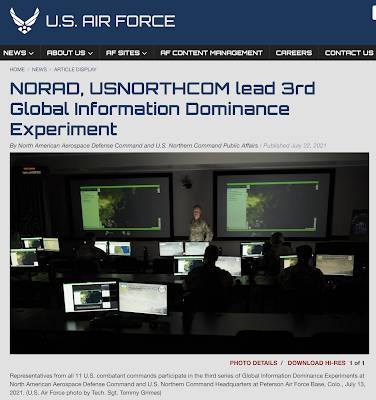
This article was last updated on April 16, 2022
Canada: ![]() Oye! Times readers Get FREE $30 to spend on Amazon, Walmart…
Oye! Times readers Get FREE $30 to spend on Amazon, Walmart…
USA: ![]() Oye! Times readers Get FREE $30 to spend on Amazon, Walmart…
Oye! Times readers Get FREE $30 to spend on Amazon, Walmart…
The United States military has a new weapon that is currently being tested and, given its capabilities, one has to wonder how long it will be before the technology is used on the civilian population.
Here is the announcement from the United States Airforce:
The Global Information Dominance Experiment 3 also known as GIDE 3 took place at Peterson Air Force Base in Colorado on July 13, 2021. The first Global Information Dominance Experiment or GIDE 1 was held in December 2020 and the second exercise or GIDE 2 was held in March 2021. The most recent exercise involved North American Aerospace Defense Command and Norther Command Headquarters. This was the third series to tests which involved representatives from all eleven combatant commands within the United States Department of Defense. While few specific details have been released, the exercise involved both military sensors and commercially available data, using both sources for domain awareness.
Here is a quote from the news release about the GIDE events as a whole and GIDE 3 in specific with my bolds:
"These experiments use technology that is available today to enable decision makers to have relevant information sooner, thus creating decision space for senior leaders by providing proactive options. The series of GIDE events are technology risk-reduction experiments that complement a shift in focus from pure defeat mechanisms toward earlier deter and deny actions well left of conflict, consistent with the Defense Department’s prioritization of integrated deterrence.
Note the rather obscure use of the words "well left of conflict" as they are key to this technology.
Let's continue with the quote:
"The Global Information Dominance Experiment 3, or GIDE 3, was executed in three synchronized but distinct stages. Stage one focused on cost-effective data solutions to increase decision space through earlier indications and warnings. Stage two evaluated the ability to respond to contested logistics and demonstrated global collaboration to rapidly create deterrence options and dynamic contested logistics planning. The final stage, stage three, demonstrated the Joint Artificial Intelligence Center’s Matchmaker capability for machine-enabled crisis deterrence and conflict defense options. This was tied to live representative threats and real-world assets allowing the participating organizations opportunities to exercise global integration.
The GIDE 3 experiment showcased how the software tools designed for cross-combatant command collaboration, assessment, and decision-making can be used to enable more effective global logistics coordination, intelligence sharing and operations planning," said Gen. Glen VanHerck, NORAD and NORTHCOM commander. "By integrating more information from a global network of sensors and sources, using the power of AI and machine-learning techniques to identify the important trends within the data, and making both current and predictive information available to commanders, NORAD and USNORTHCOM are giving leaders around the globe more time to make decisions and choose the best options available, whether in competition, crisis or conflict.""
If you are interested in further information, here is a brief and interesting video outlining the GIDE exercises:
In brief, the GIDE 3 exercise, the team aggregated early indications and warnings through 120 days of geopolitical events. Real world alerts were used to indicate the actions of adversaries, in this case, a nuclear-armed nation which was not named during the post-exercise briefing . The experiment combined the use of global sensor networks, artificial intelligence and cloud computing resources in an attempt to "achieve informational dominance" and "decision-making superiority".
After the exercise, NORTHCOM Commander General Glen D. VanHerck conducted a press briefing were he outlined some very interesting aspects of GIDE 3, again with my bolds throughout:
"GIDE also makes a concerted effort to create global integration, shifting the department away from today's regionally-focused plans, strategies, the way we do force management and force design paradigms, and budgetary and acquisition processes. We're shifting our focus away from pure defeat mechanisms for homeland defense towards earlier, deter-and-deny actions well outside a conflict. GIDE spurs faster decisions and provides proactive options by making new technologies more accessible and more effective.
Right now, the threats we face and the pace of change in the geostrategic environment continues to advance at really alarming rates. We've entered a era of new and renewed strategic competition, and this time, we're facing two peer competitors, both nuclear-armed, that are competing against us on a daily basis. We must outpace our competitors by accelerating our own efforts to transform our culture, including factoring in homeland defense into every strategy, every plan, force management, force design decision, as well as aspects of acquisition and budget so that we can deter in competition, de-escalate in crisis and if required, defeat in conflict."
Here is a key quote:
"Specific to your question about artificial intelligence and what I call information dominance, we would take artificial intelligence and use machine learning to take a look and assess, for example, the average number of cars in a parking lot that may be there in a specific location to a competitor or a threat. And we monitor that over a period of time.
The machine learning and the artificial intelligence can detect changes in that and we can set parameters where it will trip an alert to give you the awareness to go take another sensor such as GEOINT on-satellite capability to take a closer look at what might be ongoing in a specific location.
What — what we've seen is the ability to get way further what I call left, left of being reactive to actually being proactive. And I'm talking not minutes and hours, I'm talking days.
The ability to see days in advance creates decision space. Decision space for me as an operational commander to potentially posture forces to create deterrence options to provide that to the secretary or even the president. To use messaging, the information space to create deterrence options and messaging and if required to get further ahead and posture ourselves for defeat."
Let's repeat the key sentences:
"…what we've seen is the ability to get way further what I call left, left of being reactive to actually being proactive. And I'm talking not minutes and hours, I'm talking days.
The ability to see days in advance creates decision space."
Given the use of artificial intelligence, some may be concerned that machines will be making the decisions for the United States military. Not so, according to VanHerck:
"So, the first thing I would tell you that humans still make all the decisions in what I'm talking about. We don't have any machines making decisions. Certainly, machines can provide options.
So I see this not as something new that would create concern about utilizing this information to escalate. It actually is the opposite.
And — and — and keep in mind that it's not new information. It's information that today is just not analyzed and processed until later in the — the — the time cycle, if you will.
And all we're doing is taking it and sharing it and making it available sooner. So that our key decision-makers will have options vice being reactive where they may be forced to take some kind of escalation option. I hope that makes sense."
Let's close with these thoughts. General Glen VanHerck does his best to reassure us that we don't have a "Terminator-style" dystopian future where machines become self-aware and rid themselves of all of those nasty carbon-based lifeforms that are getting in the way of their dominance but he does little to reassure us that, at some point in the future, this technology won't end up being used by the private sector in combination with governments to predict our every move as is the case in a significant number of new (at the time) technologies like jet engines, ballistic missiles (space program) and nuclear technology among others. This technology also has a whiff of "precrime" about it, the basis of the movie Minority Report where the criminal justice system focussed on crimes not yet committed. But, then again, maybe my tinfoil hat is just a bit too tight today.
You can publish this article on your website as long as you provide a link back to this page.


Be the first to comment